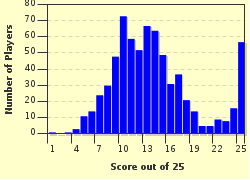Quiz Answer Key and Fun Facts
1. Which two Gospels describe the birth of Jesus?
2. When Jesus returned to Nazareth, after his temptation in the wilderness, and preached in the synagogue, how was he greeted?
3. Which of these cities did Jesus likely not visit?
4. The raising of Lazarus from the dead took place in which town?
5. Which of these is commonly given as a naturalistic explanation of the Resurrection?
6. Saul of Tarsus, later called Paul, was educated at the rabbinical college in Jerusalem. To which sect and/or group did he belong?
7. Saul of Tarsus, when he first entered Christian history, worked with the Sanhedrin to persecute the followers of Jesus. Whose execution did he attend with pleasure?
8. Shortly after his "conversion" at Damascus, Paul went to Arabia.
9. Crucifixion, a horrific death, was devised by the Romans.
10. Paul aroused the anger of silversmiths in which city by preaching against their production of idols?
11. At Pentecost, when the Holy Spirit descended upon the apostles, which prophet did Peter refer to with regard to the coming of the Holy Spirit?
12. On one occasion, when the apostles were brought before the Sanhedrin for preaching in the name of Jesus Christ, which learned Sanhedrin member rose to the apostles' defense?
13. When Paul returned to Jerusalem after his Damascus experience, whom did he first befriend?
14. In which city were Paul and Barnabas hailed as gods or divine messengers?
15. Paul visited a city in Greece which was the site of an important battle which occurred earlier. This was Paul's first mission in continental Europe. What was this city?
16. Paul was met with skepticism and rebuff when he preached in the Aeropagus in Athens. What induced the Athenian educators to curtail the meeting?
17. The image of the Madonna is most reminiscent of the iconography and appeal of which pagan deity?
18. Peter and John were preaching in Samaria when they encountered a magician or charlatan who offered Peter money for the power of the Holy Spirit. Who was this man?
19. Peter displeased the leaders in the Jerusalem church by doing what?
20. Where did Peter go after the Jerusalem Council (49 AD)?
21. Who was the eastern ruler who requested to be present at Paul's hearing before Porcius Festus (60 AD)?
22. According to tradition, when Peter was in Rome, he was persuaded to leave Rome during the Neronian persecution. He had a vision of Christ, coming towards Rome along the Appian Way. This occurred near what city gate of Rome?
23. The Basilica of St. Pudentiana was built to commemorate what site?
24. Which freedman managed civil affairs in Rome while Nero was on his tour in Greece?
25. Peter was crucified upside down in the Vatican Fields, or perhaps in Nero's Circus. According to tradition, by what means and where did Paul meet his martyrdom?
Source: Author
medvedok
This quiz was reviewed by FunTrivia editor
CellarDoor before going online.
Any errors found in FunTrivia content are routinely corrected through our feedback system.

